By MARK CANCIAN
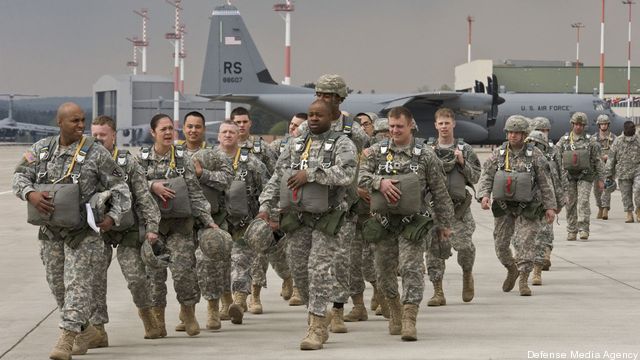 Mark Cancian, a member of the Breaking Defense Board of Contributors, knows budgets. He used to help build the defense budget at the Office of Management and Budget, the largely unheralded center of federal fiscal power. So when he picks apart the budget deal Congress recently approved (or any other one) you should pay attention. He’s doing it right here in this op-ed written for the Center for Strategic and International Studies, so read on! The Editor
Mark Cancian, a member of the Breaking Defense Board of Contributors, knows budgets. He used to help build the defense budget at the Office of Management and Budget, the largely unheralded center of federal fiscal power. So when he picks apart the budget deal Congress recently approved (or any other one) you should pay attention. He’s doing it right here in this op-ed written for the Center for Strategic and International Studies, so read on! The Editor
The budget deal’s large defense increase in fiscal 2019 allows the Department of Defense (DOD) to do a lot more than it was doing before, but not everything. A major trade-off is with force structure. The forces proposed are more than what Secretary of Defense James Mattis had originally signaled but less than what President Donald Trump’s rhetoric had implied. Other trade-offs appear in modernization — focusing on existing programs rather than starting expensive new programs, and on force mix — continuing development of some less expensive, lower-end capabilities rather than focusing completely on high-end capabilities.
At the macro level, the defense budget is a trade-off between readiness (the ability of forces to do what they were designed to do), capacity (the size of the force), and capability (the ability of forces or equipment to achieve a desired effect)—the “iron triangle of painful tradeoffs” as CSIS’s Kathleen Hicks termed it. Secretary Mattis was emphatic that the new administration would fix readiness first because of the many deficiencies he found there.
Although some problems had been long-standing, many had been exacerbated when the Obama administration changed strategy in 2014 by beginning a long air war in Iraq and Syria and instituting the European Reassurance Initiative to deter Russia. Both efforts were successful but put unplanned stress on the force, which defense budgets, constrained by the Budget Control Act and the administration’s other priorities, were inadequate to remedy.
The Trump administration’s fiscal 2017 and 2018 budgets did indeed put additional resources toward readiness—maintenance and spare parts especially. The FY 2019 budget maintains the increase and enhances it in places. However, the budget’s major focus shifts to modernization. This shift signals a recognition that readiness is not infinitely valuable. Readiness is very expensive, and the department will buy what it needs but then focus on other priorities. Increasing force size (capacity) might have been one of these other priorities, but the administration has clearly been conflicted about this.In September 2016, then-candidate Trump proposed an Army of 540,000 regular soldiers, a Navy of 350 ships, and an Air Force of 1,200 fighters.This force was derived from work that the Heritage Foundation had doneand which had received considerable attention in conservative circles. However, Secretary Mattis signaled many times in the past year that his focus would be on capability (“lethality” as he likes to call it), and he pointedly left force expansion out of his lists of priorities. General Joseph Dunford, chairman of the Joint Chiefs of Staff, was blunter: “I don’t see, in the near term, our ability to really grow the force.”This emphasis on capability is consistent with the National Defense Strategy (NDS) focus on “long-term great power competition” with Russia and China. The tension played out in drafts of the National Defense Strategy (unclassified summary).
Early drafts omitted discussion of force size, but the White House and National Security Council reportedly pushed back. Consequently, the final document includes: “The size of our force matters.” Thus, the budget contains a compromise: some force expansion, but not nearly what had been suggested earlier.
Consistent with the strategy, modernization (capability)—buying new equipment for the forces—receives a large increase. Between the FY 2018 President’s Budget (PB) and the president’s FY 2019 proposal, DOD procurement increases $19 billion, and research, development, test, and evaluation (RDT&E) increases $18 billion. However, there are no new major acquisition programs but, instead, a focus on continuing production of existing systems. This was another trade-off.
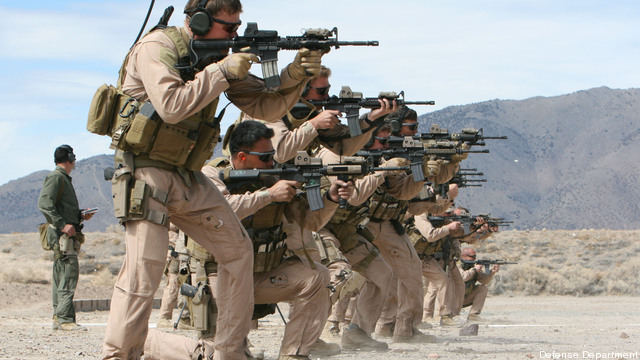 While the strategy might imply the need for additional, advanced technology weapons systems, beginning new multibillion-dollar programs is a bet that the budget will remain high for many years in order to accommodate the increased resource demands. However, continuing budget uncertainty makes this bet iffy and hedging seems prudent—i.e., buy what is available now while the budget window is open.
While the strategy might imply the need for additional, advanced technology weapons systems, beginning new multibillion-dollar programs is a bet that the budget will remain high for many years in order to accommodate the increased resource demands. However, continuing budget uncertainty makes this bet iffy and hedging seems prudent—i.e., buy what is available now while the budget window is open.
It may be that new acquisition programs emerge in the future from the primordial soup of ongoing research and development. Hypersonics/conventional prompt strike, advanced aircraft, directed energy, and robotics are candidates. Time will tell.
The most striking modernization change is the large increase in munitions procurement of all kinds—air-to-air and air-to-ground; precision and nonprecision ground-to-ground; long range and short range; missile defense; and antiship. This indicates both a preparation for high-end conflicts with other great powers and the need to replenish inventories for conflicts against regional powers such as Korea or against insurgent groups in the Middle East.With these broad themes in mind, let’s take a look at the individual services.
Army. There are two major takeaways about Army plans: the force will increase to 487,500 regular soldiers in FY 2019 with an ultimate goal of 495,000; and, consistent with the broader theme, modernization focuses on production of existing systems rather than starting new programs.The force expansion is something of a surprise because the NDS would seem to emphasize naval and air capabilities. The Pacific theater is mainly ocean and long distances, and European geography in the most pressing scenario, defense of the Baltic states, makes deployment of large ground forces difficult.It is a tribute to the Army leadership that they convinced policymakers of the need for expansion. Despite the manpower increase, the Army will not build more brigade combat teams, but instead will fill out manning in its existing units and add some new capabilities.
The former is an important enhancement to readiness and deployability. When units are undermanned and need to deploy, they pull personnel from other units (called “cross leveling”), which engenders a cascading disruption of units. The latter—new units for cyber, advising and assisting allies and partners, and air defense—leverages emerging technologies and responds to the new strategy.
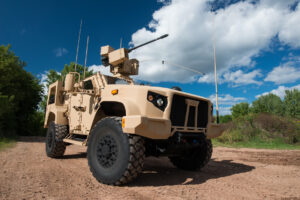 Interestingly, force expansion in the reserve components is modest: in FY 2019, 500 for the Army National Guard and 500 for the Army Reserve. That means that 87 percent of Army force expansion is in the active component. Normally, this would engender some grumbling from the politically powerful reserves, but the Army leadership has apparently worked closely with them. The budget implements the agreement from the 2016 National Commission on the Future of the Army, particularly the maintenance of Apache helicopters in the Guard. Guard rotations at the combat training centers also increase from two to four.In modernization, some programs increase (M-1 tanks, Joint Light Tactical Vehicle trucks, Armored Multipurpose Vehicles); others stay about the same (helicopters, M-2 Bradleys). There are no new acquisition programs. Development continues on the next-generation fighting vehicle and future vertical lift aircraft, both Army priorities, but they are not proposed as programs of record for procurement. This picture might change in the next year as the Army’s new modernization command takes shape and the recently established cross-functional teams produce results. Nevertheless, the Army’s incremental modernization strategy seems deeply embedded and likely to continue.
Interestingly, force expansion in the reserve components is modest: in FY 2019, 500 for the Army National Guard and 500 for the Army Reserve. That means that 87 percent of Army force expansion is in the active component. Normally, this would engender some grumbling from the politically powerful reserves, but the Army leadership has apparently worked closely with them. The budget implements the agreement from the 2016 National Commission on the Future of the Army, particularly the maintenance of Apache helicopters in the Guard. Guard rotations at the combat training centers also increase from two to four.In modernization, some programs increase (M-1 tanks, Joint Light Tactical Vehicle trucks, Armored Multipurpose Vehicles); others stay about the same (helicopters, M-2 Bradleys). There are no new acquisition programs. Development continues on the next-generation fighting vehicle and future vertical lift aircraft, both Army priorities, but they are not proposed as programs of record for procurement. This picture might change in the next year as the Army’s new modernization command takes shape and the recently established cross-functional teams produce results. Nevertheless, the Army’s incremental modernization strategy seems deeply embedded and likely to continue.
DDG-51 class destroyer, USS Curtis Wilbur
Navy. Like the Army, the Navy expands forces and increases procurement of existing programs but starts no major new programs. Active-duty manpower increases from 327,900 in the FY 2018 PB to 335,400 in the FY 2019 proposal, with an ultimate goal of 344,800. This increase will build crews for new construction ships and fill manning gaps on existing ships. A theme that has come out of recent accident investigations is that low crew manning, both by design and by policy, hurts operations.
In shipbuilding, the Navy proposes buying 10 ships, an increase of one from PB FY 2018. Compared to last year’s request, construction of DDG-51 Arleigh Burke destroyers (Flight III ships equipped with the Advanced Missile Defense Radar) would increase from two to three, while the number of the Littoral Combat Ships would decrease from two to one awaiting the follow-on frigate program. Total shipbuilding funding increases from $20.4 billion in the FY 2018 PB to $21.9 billion in FY 2019.
The modest increase highlights the challenge in building a larger fleet. Fleet size will increase to 299 ships in FY 2019 as previously funded ships are delivered, but, according to the Navy’s long-term shipbuilding plan, fleet size peaks at 342 in FY 2039 and never reaches the 355 ship goal.
In aircraft procurement, the Navy continues to hedge its bets, funding both fifth-generation F-35 Joint Strike Fighters (29) and fourth-plus generation F-18E/F fighters (24). The Navy’s ambivalence to unmanned aircraft continues. It puts $719 million toward development of the unmanned MQ-25 Stingray tanker, a big jump from the $222 billion in the FY 2018 PB, but the fielding date has been delayed to 2026, and it is not yet an official program of record. Further, the Navy does not propose any unmanned combat aircraft.
The future frigate program and continued procurement of the F-18—in effect, a high-low mix for ships and aircraft—show a hedging strategy. Although these systems are not well-suited for great power conflicts, their lower cost allows some expansion of the force structure to meet day-to-day demands for presence and crisis response, and they are suitable for conflicts against regional adversaries.
Marine Corps. Unexpectedly for such a manpower intensive service, the Marine Corps increases active-duty manpower by only 1,100, from 185,000 in FY 2018 PB to 186,100 in the FY 2019 proposal, with an ultimate goal of 186,400. The increase goes mostly to what the Marine Corps calls a “fifth generation force”—cyber, security cooperation, information warfare, and special operations—rather than traditional Marine Corps areas such as ground combat units.
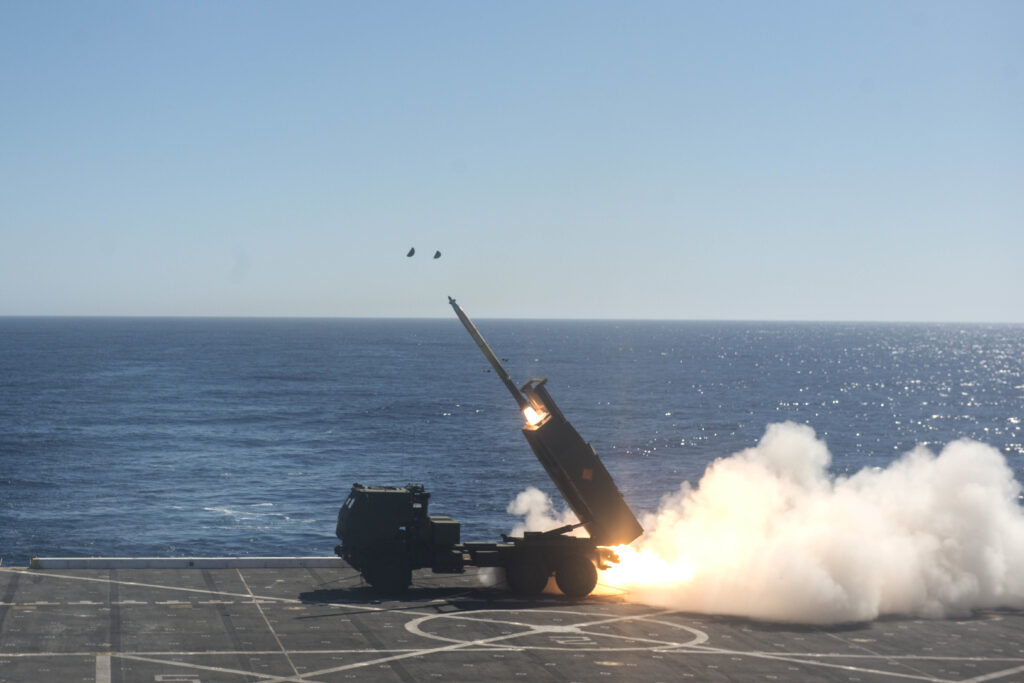 A Marine HIMARS missile launcher fires from the deck of the USS Anchorage during the Dawn Blitz 2017 exercises.
A Marine HIMARS missile launcher fires from the deck of the USS Anchorage during the Dawn Blitz 2017 exercises.
A national strategy focusing on great power competition produces tensions in the Marine Corps, which describes itself as a “middle weight force” and has traditionally had few high-end capabilities. It finds itself in the situation of the late 1970s, when DOD’s attention focused on NATO after a decade of combat in Vietnam, and the Marine Corps struggled to find a place in that strategy.
In procurement, the Marine Corps buys more early production Amphibious Combat Vehicles—an advanced, eight-wheeled armored personnel carrier—as part of its 30-year effort to replace existing ship-to-shore amphibious assault vehicles (AAVs). Nevertheless, the Marine Corps continues to upgrade its existing AAV as a hedge.
Air Force. Continuing a theme, the Air Force grows its force modestly and procures existing systems. Active-duty end strength increases by 4,000, from 325,100 in the FY 2018 PB to 329,100 proposed for FY 2019. This fills shortfalls in existing units and expands some high-end capabilities such as cyber and intelligence. It may also mark the end of the Air Force’s attempt to trade personnel and size for modernization. Although its need for modernization has been great, the global demand for existing units and the strategic demand for new kinds of units has continually overwhelmed Air Force attempts to shift resources.
Reserve end strength also increases but much less, 700 total. As with the Army, reserve component acceptance of this disparity indicates a restoration of confidence as a result of a force structure agreement, the 2014 National Commission on the Structure of the Air Forcein the case of the Air Force.
Procurement includes F-35 production at 48 per year, a slight increase from the 46 proposed in FY 2018 but not at the level of 60 per year that the Air Force desires. The Air Force also procures 15 of the new KC-46 tankers, 7 M/HC-130s, mainly for special operations, and the first 10 of the long-delayed replacement for aging combat search and rescue helicopters.
Two aircraft proposals indicate force structure trade-offs. The B-52s will continue flying far into the future, even as the newer B-1s and B-2s retire when the B-21 enters the force in the 2020s. The B-52 is relatively easy to operate and has been so useful in recent conflicts that its life span has been extended yet again. The last B-52 pilot has not yet been born. The Air Force also continues its commitment to a light attack aircraft program for conflicts in relatively benign air environments. Both proposals implement a high-low mix and, as with the Navy, indicate a desire to maintain enough force structure to meet the demands of day-to-day commitments and conflicts with regional adversaries within constrained resources.
B-21 Raider artist rendering
The Air Force proposes buying 29 MQ-9 Reaper remotely piloted aircraft (RPAs), using both base and war funding. This seems low, given the retirement this year of 150 Predators that have been a major part of the Air Force’s recent combat operations. Further, Predators and Reapers, while extremely valuable in environments without strong air defenses, are highly vulnerable in great power conflicts. This may indicate that additional RPA programs lie in the black (secret) world and have not yet been revealed publicly. It would be regrettable, however, if instead the FY 2019 budget represents a reversal of progress in expanding use of unmanned technologies.
The Air Force’s big push is in R&D, which increases by nearly $5 billion. This supports further development of nuclear modernization, an administration priority—B-21, intercontinental ballistic missile (ICBM) follow on (called the Ground-Based Strategic Deterrent), and the Long-Range Standoff Missile. There is additional effort in space, perhaps in reaction to criticism that the Air Force has not paid sufficient attention to space and to head off the suggestion that a separate space corps be established. Finally, there’s development of a replacement for Air Force One (called the Presidential Aircraft Replacement).
Future challenges. The challenges will be twofold. The first is actually getting the money to execute all these expanded plans. There is bipartisan support for a defense buildup, and the administration forecasts continued high defense budgets. However, pressure from interest payments, expanding entitlement programs, and domestic priorities, coupled with an uncertain balance of power in future Congresses may derail these plans. The second challenge is whether the strategy of focusing on great power competition can survive the demands of day-to-day operations. Administrations often desire to cut back on the high level of ongoing operations in order to ease stress on the force and focus funding elsewhere, but the claimants—regional headquarters, allies and partners, commanders of ongoing conflicts—make this hard to implement.
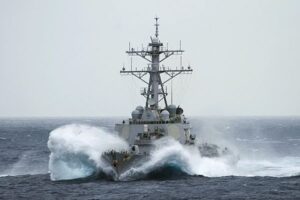
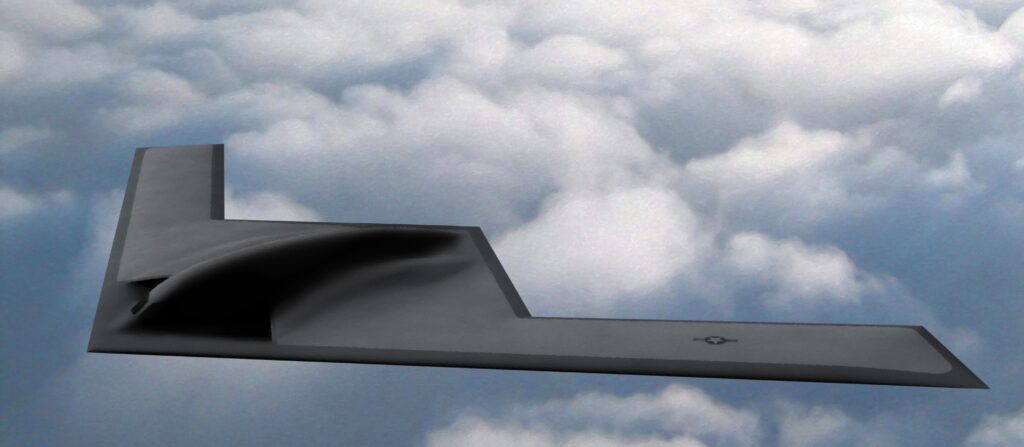
No comments:
Post a Comment